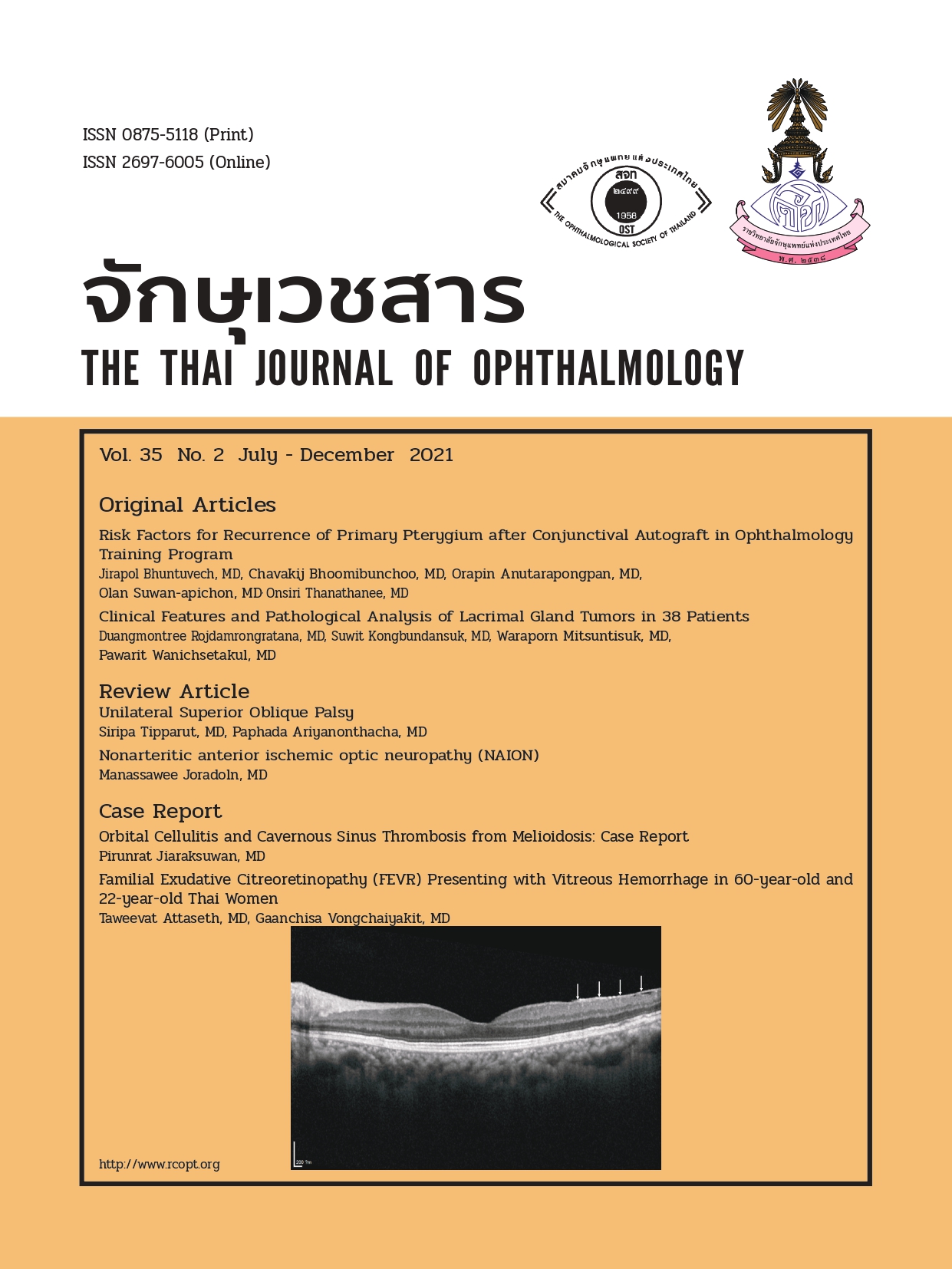Unilateral superior oblique palsy
Keywords:
กล้ามเนื้อ superior oblique palsy อ่อนแรง, สายตาเหล่ในแนวตั้งAbstract
กล้ามเนื้อ superior oblique palsy อ่อนแรงเป็นสาเหตุของสายตาเหล่ในแนวตั้ง (vertical diplopia) ที่พบมากที่สุด1 โดยพบทั้งที่เป็นแต่กำเนิด(congenital superior oblique palsy) และเกิดขึ้นภายหลัง (acquired superior oblique palsy) อัตราการเกิดกล้ามเนื้อ superior oblique อ่อนแรงแต่กำเนิด 3.4 คนต่อประชากร 100,000 คน คิดเป็น 31% ของผู้ป่วยเด็กสายตาเหล่ในแนวตั้ง2 และอัตราการเกิดกล้ามเนื้อ superior oblique อ่อนแรงภายหลัง 6.3 คนต่อประชากร 100,000 คน โดยพบในเพศชายมากกว่าเพศหญิง3 จากการศึกษาพบอัตราการเกิดกล้ามเนื้อ superior oblique อ่อนแรงตาเดียวมากกว่ากล้ามเนื้อ superior oblique อ่อนแรงสองตามาก 133 ต่อ 10 คน4 นอกจากนี้ผู้ป่วย superior oblique อ่อนแรงแต่กำเนิด มักพบการฝ่อของกล้ามเนื้อตาและ ไม่มีเส้นประสาทสมองคู่ที่สี่ข้างเดียวกัน (ipsilateral trochlear nerve)
References
2. Tollefson MM, Mohney BG, Diehl NN, Burke JP. Incidence and types of childhood hypertropia: a population‐based study. Ophthalmology 2006;113(7):1142‐5.
3. Martinez‐Thompson JM, Diehl NN, Holmes JM, Mohney BG. Incidence, types, and lifetime risk of adult‐onset strabismus. Ophthalmology 2014;121(4):877‐82.
4. Mollan SP, Edwards JH, Price A, Abbott J, Burdon MA. Aetiology and outcomes of adult superior oblique palsies: a modern series. Eye (Lond). 2009 Mar;23(3):640-4.
5. Abdelhady A, Patel BC, Aslam S, et al. Anatomy, Head and Neck, Eye Superior Oblique Muscle. [Updated 2020 Aug 10]. In: StatPearls [Internet]. Treasure Island (FL): StatPearls Publishing; 2020 Jan-
6. Knapp, P. (1974). Classification and Treatment of Superior Oblique Palsy. American Orthoptic Journal, 24(1), 18–22
7. Dwivedi R, Marsh IB. Superior oblique tuck: evaluation of surgical outcomes. Strabismus. 2019 Mar;27(1):24-29.
8. Yang S, Yue Y, Wang P, Chen G. Superior oblique tendon advancement: its success as single or combined muscle treatment for selected cases of unilateral superior oblique palsy. Strabismus. 2020 Mar;28(1):25-28.
9. BCSC section6, Pediatric Ophthalmology and Strabismus, American Academy of Ophthalmology. 2019-2020
Downloads
Published
Issue
Section
License
Copyright (c) 2021 The THAI Journal of OPHTHALMOLOGY

This work is licensed under a Creative Commons Attribution-NonCommercial-NoDerivatives 4.0 International License.
The Thai Journal of Ophthalmology (TJO) is a peer-reviewed, scientific journal published biannually for the Royal College of Ophthalmologists of Thailand. The objectives of the journal is to provide up to date scientific knowledge in the field of ophthalmology, provide ophthalmologists with continuing education, promote cooperation, and sharing of opinion among readers.
The copyright of the published article belongs to the Thai Journal of Ophthalmology. However the content, ideas and the opinions in the article are from the author(s). The editorial board does not have to agree with the authors’ ideas and opinions.
The authors or readers may contact the editorial board via email at admin@rcopt.org.


